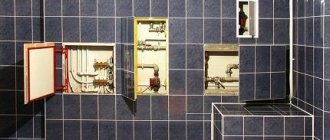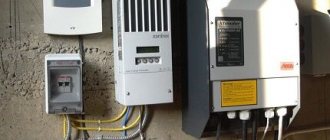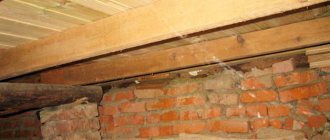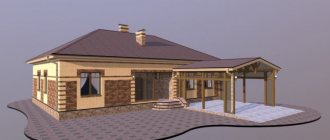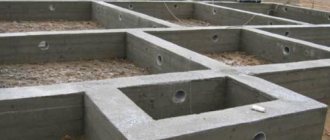The durability of a private house made of any building material largely depends on regular ventilation of the space located under the lower ceiling. The ideal option is when underground ventilation in a private house is designed and implemented during the initial stage of construction. Then it is calculated and arranged correctly.
You will learn everything about the competent organization of a system designed to remove excess moisture from structures partially or completely buried in the ground in the following article.
We will talk about the important functions performed by ventilation. We will show you how to correctly position and install components designed to remove exhaust air and supply fresh air.
Why is floor ventilation needed?
Ventilation for wooden floors is necessary for one simple reason: wood without proper ventilation begins to gradually become damp and rot, that is, to collapse.
And the base, the so-called subfloor, on which the insulation will subsequently be laid, is made of wood. The gradual destruction of wood will inevitably lead to the fact that one day the floor will simply collapse. You will have to disassemble the entire structure and reassemble it, this time following all the rules. But there is a danger much greater than the collapse of the floor structure.
These are fungi and mold that can multiply in underground dampness. Fungal spores can cause catastrophic damage to the health of people living in the house, causing serious illnesses. And if there is increased dampness in the house when the heating is turned off, this is a pretty serious cause for concern. So ventilation of a wooden floor is a necessary thing.
Should you close the vents for the winter or not?
There are two points of view on whether to close the ventilation holes in the underground for the winter or not. If they are left open, moisture will not accumulate. And this is good, but in return we get a cold floor and increased heating costs. The solution is enhanced floor insulation so that ventilation does not affect its temperature and does not require increased heating.
If the vents are closed for the winter, moisture accumulates in the soil. Warm, moist air from the house enters the floor, falling on cold surfaces, and in winter these are the walls of the basement, the moisture condenses and flows into the ground. This means that later, in the summer, it will evaporate from there, increasing the humidity in the basement.
Requirements for ventilation of the subfloor of the house
As a rule, when building houses on a strip foundation, the diameter of the vents is made too small, so high-quality ventilation in the underground of a private house does not work.
Ventilation of strip foundations
From the point of view of the process of arranging vents, the strip foundation is arranged in a more complex way than the pile version of the foundation. Indeed, in addition to the external tape that holds the walls of the house, inside such a foundation there are special partitions on which the internal interior partitions are based.
Therefore, the process of forming ventilation channels in the strip base is as follows:
- First, the number and dimensions of the vents are calculated.
- Next, the formwork is assembled for pouring the foundation strip.
- Upon completion of assembly, the formwork is filled with reinforcement and mortar to ½ of the height of the foundation.
- After this, wooden blocks wrapped in roofing material are placed in the required places - at a distance of ¼ of the total length of the front or side section of the tape from each external corner.
- The same bars are laid in the internal sections of the foundation strip, placing them along the axis of the future ventilation duct.
- Next, you need to fill the formwork with mortar to the calculated height of the foundation.
After a week, you will remove the formwork and push out the wooden block from the tape, which will slide out of the roofing felt wrapper, opening the air channel.
conclusions
The installation of vents in the foundation of a private house is a mandatory requirement if there is a strip base and an unheated underground space. Effective ventilation of the subfloor is necessary to ensure the durability of the building in both warm and cold seasons. In winter, partial closing of some vents is allowed in order to reduce heat loss from the building. For this purpose, ventilation grilles with dampers and various available materials are used, for example, insulation in the form of polystyrene foam, expanded polystyrene or mineral wool. However, a ventilation system using vents must also work in winter, since the lack of effective ventilation will lead to extremely unpleasant consequences, more serious than an increase in heating costs for the building.
vote
Article rating
Which ventilation scheme should I choose?
So, we have figured out whether an underfloor ventilation system is needed, and now it remains to decide which scheme to choose for specific conditions. There are several important points to consider when choosing a system. The operation of ventilation largely depends on the type of climate in a particular area, average street temperature, etc.
When installing natural ventilation, the main rule must be observed: the supply openings are located below the exhaust openings. The greater the altitude distance between them, the more efficient the system is.
Natural ventilation is more effective in winter, since it is at this time that a large difference is recorded between the temperature inside the underground and outside, which ensures good circulation of air masses.
However, with an even greater drop in temperature, there is a possibility of an excessive increase in air exchange, which is also not particularly good, as it can lead to freezing of structures. Therefore, if the temperature drops significantly, the vents must be closed.
In summer, the difference in temperatures inside the underground and outside is minimized, so air circulation may stop. Therefore, natural ventilation, even with a supply and exhaust system, is not the best option for hot regions. A combined ventilation system with pipes should be installed here.
If the house has supply and exhaust ventilation, it makes sense to connect the exhaust from the basement to the general circuit. This way, the outflow of air will be stimulated in any weather.
To install a combined ventilation system for a small underground area, it will be enough to install one pipe. In order for it to provide both output and reception of air masses, it needs to be divided vertically into 2 channels.
Such ventilation pipes are sold in hardware stores. Each channel has its own valve to adjust the flow intensity. The functioning of such ventilation is checked quite simply: you need to attach a sheet of paper to the outlet holes one by one.
Materials for the system design
For the arrangement of supply and exhaust ventilation air ducts, 3 types of pipes are used:
- Asbestos-cement ones are durable, resistant to corrosion and withstand frost well. They are of sufficient length, so during installation you can do without connections;
- Galvanized steel – resistant to corrosion, easy to install, and light weight. However, the price for metal components of ventilation systems is usually higher than for plastic and asbestos-cement ones;
- Plastic ones have a smooth inner surface, which ensures easy and fast air flow. Plastic pipes do not rust, they do not need to be cleaned, and their service life exceeds a couple of decades. One of their drawbacks is flammability.
The determining factor in the effectiveness of the ventilation system is the proportionality of the cross-section of the installed air duct to the area of the room in which it is installed. Heating engineers recommend adhering to the following norm when making calculations: 26 cm2 of section is required for 1 m2 of subfloor.
The most practical option for laying the exhaust part of the ventilation system in the cellar is an assembly of polymer pipes. In addition to the affordable price, the opportunity to build a pipeline with your own hands is also attractive.
There is the following formula for calculating the required pipe diameter:
(S cellar × 26) ÷ 13.
That is, if the underground area is 9 m2, then a pipe with a diameter of 18 cm will be required: (9 × 26) = 208 ÷ 13 = 18 cm. For single-pipe ventilation, the diameter should be even larger, for example, 20 cm.
Ventilation installation process
A wooden house made of timber, laminated timber and logs in the classic version is erected on a strip concrete foundation, which allows the wooden structure of the building to be separated from the ground.
The space between the ground level and the subfloor with the floor joists is the crawl space. A finished floor structure with insulation is mounted on the floor beams. The soil under the floor creates dampness from evaporating moisture, which settles in the form of steam on wooden structures, creating conditions for the growth of bacteria, mold and fungi.
Natural floor ventilation - how to do it yourself?
It is ideal if the vents in a wooden house are laid directly when pouring the strip or column foundation of a residential building. Everything is simple here. You need to buy ready-made forms for vents at a hardware store or make them yourself from scraps of metal pipes.
Natural ventilation is installed from the ground surface at a height of approximately 0.5 m. If the vents are installed lower, there is a chance that they will be covered with snow or flooded with water during floods. The diameter of the ventilation holes to be installed is taken to be about 11 cm. Vents are placed every 250–300 cm.
Domestic sanitary standards and rules require that the total area of openings for natural ventilation in a private house occupy 1/400 or more of the area of the entire floor base. Don't try to save time and effort by punching few holes.
It’s better to do everything right and enjoy the ideal microclimate in your home than to constantly suffer from poorly executed floor ventilation. Important point! The very last vent on the wall should be located at a distance of more than 100 cm from the corner of the foundation of the house. If you do not pay attention to this recommendation and place the hole closer, unventilated zones will certainly form in the underground. Ventilation can also be done in an already used house. The task will be time-consuming, but not at all difficult. You will need pipe products for the air ducts, as well as clamps and deflectors to secure them.
Also stock up on the tools necessary to punch ventilation holes in the foundation of the building where you will install the pipes. After punching the vents, install the pipes and secure them. Important! Supply and exhaust pipes are always located at opposite ends of the underground. One of the ends of the supply hose is located from the ground at a height of 0.5 m, and the second - 50 cm from the floor. The hood must be installed so that it rises 0.5–0.6 m above the roof of the house.
Forced
This system is usually used in cases where the building is located in a low-lying area and natural ventilation has too little effect. It is also relevant to use when:
- the volume of the underground space is quite large, and natural ventilation cannot cope;
- there is increased humidity in the underground, and/or mold has already been noticed;
- The climate is characterized by rainy weather.
Forced ventilation involves both supply and exhaust of air using fans. In more detail:
- Holes are drilled in one of the walls in the underground and fans for supply are inserted into them. They will force air into the underground. They need to be placed evenly along the length of the wall so that there are no blind areas with stagnant air.
- Holes are drilled in the opposite wall and exhaust fans are inserted into them. They will draw stale air outside. They also need to be spaced evenly.
Alternatively, in forced ventilation systems, exhaust can be done through a common house shaft (if there is one). However, this option can be conveniently and simply done only at the stage of designing and building a house. If the building is already ready, then the easiest way is to do both supply and exhaust through fans in the walls.
The advantages of such a system include:
- independence from weather conditions (unlike the natural system);
- the ability to move large volumes of air (relevant for large spaces);
- the ability to automate the process: fans can turn on and change speed based on readings from humidity sensors.
Of the minuses:
- higher cost: you will have to spend money on fans (however, the amount will be relatively small: 1 very simple fan can cost several hundred rubles);
- fixed electricity costs.
Why ventilate the underground?
If ventilation is not provided in an uninsulated foundation, humidity in the underground quickly increases, which sooner or later turns into condensation. Moisture in the form of steam comes through the ceilings from the house, as well as from the ground. Since there is no ventilation of the foundation, there is no way to remove it; it accumulates in the soil under the house, in the walls of the basement, and settles on floor beams, on subfloor boards and/or sheathing materials. Where there is a positive temperature and high humidity (under a heated house, even in severe frosts, the temperature is always above zero), bacteria and fungi always multiply very actively, and materials rot. As a result, very unpleasant odors penetrate into the house and materials are destroyed.
This is what a subfloor without ventilation looks like after a few months.
The second reason why underground ventilation is necessary is radon gas, which is released from the soil, and sometimes in considerable quantities. It is a naturally occurring radioactive gas. Without ventilation, radon accumulates in the upper part of the underground space and gradually seeps into the house. It is probably not necessary to tell what the presence of radioactive gas in residential premises can lead to. So this is another good reason why it is necessary to ventilate the subfloor.
There are two ways to ventilate the underground space:
- Make vents in the foundation (also called vents). In this case, moisture is removed due to a draft - ventilation holes are located in opposite walls.
- Organize the exhaust of air from the underground - lead the ventilation pipe to the roof, and the supply of air through the grilles in the rooms. In this case, there are no vents in the foundation, but it is necessary to do thorough external insulation of the foundation + basement + blind area. Then cover the soil inside the subfloor with waterproofing.
The second solution makes it possible to improve aesthetics and prevent the subfloor from getting cold due to drafts, but it requires significant material investments. This option is suitable if you are going to build an energy-saving, well-insulated house. In all other cases, it is more appropriate to vent the foundation.
Types of floors
Wooden floor ventilation device
From the point of view of the correct engineering approach, the installation of floor ventilation in a house should begin with determining the requirements that building codes and regulations (SNIP) impose on such systems. Experience in operating wooden floors and calculations show that effective air exchange is achieved subject to the following conditions:
- Holes are made on the windward and leeward sides. Knowing the wind rose in the region will help you make the right choice.
- The ratio of the cross-sectional area of the vents to the total area of the subfloor is 1 to 400.
- The holes are located at a height not lower than the limit of a possible rise in the water level (usually 15-20 cm or more) to avoid flooding in the spring. And no further than 0.9 m from the corners, so that there is no air stagnation.
- The height difference between the supply and exhaust openings is at least 15 cm (the supply openings are located below the exhaust openings).
- The presence of partitions inside the subfloor requires the installation of additional vents in them.
- Providing effective traction. To strengthen it, boxes made of galvanized sheet of small diameter are attached to the vents, raising them to a sufficient height, or additional holes are drilled in the base.
- Year-round ventilation. In winter, you can reduce the effective area of the holes by covering them a little, but covering them completely is unacceptable.
The outlet openings of the vents are equipped with gratings that prevent the possibility of various living creatures - mice, rats and other rodents - entering the space under the house.
In houses on strip foundations, the simplest ventilation system is used, laying in the required number of vents when pouring the foundation. Wooden blocks of suitable size (usually 10x10 cm), wrapped in plastic film, are used as bookmarks, which makes them easy to remove after the foundation hardens. You can also use pieces of plastic pipe, which can later be easily fitted with a deflector or rodent grill. This scheme is also suitable for columnar foundations with a grillage made of wooden, metal or concrete beams.
When the height of the subfloor is small (less than 25-30cm), then vents in the wooden floor are organized near the wall. At the same time, it is important not to allow them to overlap with pieces of furniture or floor coverings.
If a house is built on a columnar foundation with a monolithic grillage or on a concrete slab as a base, it will not be possible to organize such ventilation. Therefore, another method is used to ensure air circulation. It consists of making vents in the floor, along the perimeter of the room, and installing ventilation grilles on them, thereby creating an influx and outflow of air into the space under the floor. It is recommended to make a hole for installing the grating in the place where one floorboard adjoins another - at the joint, then sufficient strength of the floorboards is maintained. The use of special slotted skirting boards is even more effective - the volume of air exchange through them is approximately 10-15 times higher than through ventilation grilles.
Concrete floor
Make a gasket with waterproofing, and then put insulation.
Dirt floor
Concreting and screeding.
Insulating the subfloor in a wooden house involves installing a vapor barrier. It is very important for wooden structures. Serves to prevent moisture ingress. Isopan is well used in this case. It is very popular and consists of two layers. Sold in rolls. The length is 16 meters.
Why is ventilation needed?
Ventilation of a wooden floor in a private house must be organized for many good reasons. If the building was built without a ventilation device for the underground volume, it is necessary to correct this by independently installing ventilation holes and ducts (depending on the structural and operational features of the house).
The main reason that encourages you to take a responsible approach to the issue of ventilation of the underground space is dampness. It is necessarily present to one degree or another under the floor of every private house, no matter how dry the soil may seem.
Moisture evaporation from the ground rises upward and settles on load-bearing, wooden, and concrete structures, slowly but constantly causing damage to underground structures. Concrete elements deteriorate over time, metal elements gradually corrode.
Wooden lintels and structures rot and collapse when exposed to moisture. In addition, during decay, rotting wood provides a breeding ground for mold and mildew. Invisible spores penetrate upstairs, into the rooms of the house, having a depressing effect on the microclimate of the premises.
Gradually, over time, a private building will collapse at its foundation; it is not possible to correct this after a certain critical level. Warming up the house from the inside does not affect the drainage of the underground space, since modern hydro- and heat-insulating floor materials do their job well.
Ventilation baseboards and grilles
To ensure good air circulation in the space between the rough and finished floors, the following method is used. When laying finished floor boards, a gap is left between the wall and the edge of the last board - about 2.5-3 cm, which is subsequently covered with a plinth. In the corners of the room, retreating 15 cm from the baseboard, holes are made for ventilation and covered with ventilation grilles.
Often, to increase the rate of air exchange, in addition to the grilles, special ventilation plinths are installed, in which there are holes for air passage with a diameter of about 10 mm. The plinth is attached along its entire length on two opposite sides of the room.
High rates of air exchange are achieved by using a slotted plinth, when, when installing it, wooden pads 12 mm thick are placed under the material every 50-75 cm. The resulting gaps ensure good ventilation of the space under the floor.
It should also be noted that advice, consultation or simply the presence of a specialist when installing a ventilation system for plank floors will help avoid annoying mistakes in such a simple process.
What should be the vents in the foundation and how to position them
Ventilation holes in the foundation are made of round or square cross-section. If desired, it can be triangular or any other shape. If only they were large enough in area to effectively remove moisture from the subfloor.
Dimensions
The dimensions of ventilation holes in the foundation are regulated by SNiP (SNiP 31-01-2003). Paragraph 9.10 states that the area of the vents must be at least 1/400 of the total area of the subfloor. For example, if you have a house measuring 8*9 m, the underground area is 72 square meters. m. Then the total area of vents in the foundation should be 72/400 = 0.18 sq.m. or 18 sq. cm.
The same paragraph of the standard specifies the minimum ventilation area - it should not be less than 0.05 sq.m. If we translate into dimensions, it turns out that rectangular holes should not be less than 25*20 cm or 50*10 cm, and round ones should have a diameter of 25 cm.
Larger holes can be made
In multi-storey buildings this is done, but in private buildings such holes look too large. Usually they are made two times smaller, while increasing the number of vents so that the total area of the vents is not less than the recommended one.
How to position
Make vents in the foundation 15-20 cm below the top edge of the tape. If the base is low, a recess is made in front of the vent - a pit. But ventilation of the underground is required.
The vents in the base are placed evenly on all sides of the foundation opposite each other. This is necessary for the foundation ventilation to work properly. The wind, “flying” into one hole, will fly out into another, taking with it water vapor and radon.
The distance between two adjacent vents in the basement is about 2-3 m. If there are any partitions inside, at least one vent is needed for each “room”. It is also necessary to make vents in the partitions themselves to allow air masses to move and form a draft. This is exactly what we need. In order for movement to be more or less free, the area or number of holes in the internal partitions must be larger and better, if it is 2-3 times larger. You can make several holes the same size as in the base, or you can make one, but wide one. The second option, by the way, is preferable - the resulting passages can be used to service the underground.
If you don’t find a grate of a suitable diameter, you can do this
Vents in the foundation of any format must be covered with gratings to prevent living creatures from entering the underground. It is desirable that the grilles are metal and the holes are small. For mice, plastic is not a problem, and keeping them out is easier than dealing with them later.
This option improves ventilation conditions and protects against rodents
Features of the ventilation device
If there is space left under the floor of the house, its ventilation is most often organized by installing vents inside the base. Ventilation openings are designed at precisely calculated distances from each other, from the ground level, from the corners of the building and taking into account other factors.
Ventilation openings are covered with ventilation grilles to protect against rodents. This is a traditional solution for organizing a natural ventilation system
For greater efficiency of the ventilation process, vents are selected on the leeward side and in the wall of the base/foundation located opposite. The ventilation holes should be opposite each other. With this solution, cravings increase naturally.
The wind, flying into the hole on one side, will fly out into the ventilation hole on the other side, taking with it moisture, volatile carbon dioxide molecules and a musty smell. During further operation, you just need to make sure that the ventilation openings are not blocked by any objects from the inside and are not overgrown from the outside.
In a strip foundation, the vents are located opposite each other to ensure a stable natural air flow
If there are partitions inside the foundation, ventilation holes are also made in each of them. To ensure that the movement of air masses is stable and free, the internal vents are located directly opposite the vents selected in the external walls.
If it is impossible to select the required number of holes in the walls of the plinth or foundation, increase the area of each mini-opening. It is important that the total ventilation area meets regulatory requirements.
For normal ventilation of the subfloor, it is necessary to ensure sufficient air flow - the dimensions of the ventilation holes must meet regulatory requirements
You can make a series of holes of the same size, or you can make one wide window with a grille or an opening sash. When installing a window, there must be a passage or hatch inside the structure that can be opened for periodic burst ventilation.
You can cut ventilation openings in the foundation/basement of an already erected structure using a mobile drilling machine designed for horizontal drilling and drilling walls. To form a hole, you will need a projectile equipped with a diamond crown.
Ideally, vents in the external and internal walls of the foundation, passages and large openings for ventilation pipes should be laid before pouring the mortar into the formwork.
If there is an additional foundation inside, for example, for a brick oven or a massive floor-standing gas boiler, then inside the outer base the number of holes must be increased by 1.5-2 times.
Vents can be not only round, but also square, rectangular and even triangular. The main thing is not to reduce the total cross-section specified in the building regulations. The size of the hole should not impede the flow of the required amount of air.
It's never too late to make vents in the foundation or basement. They can be punched with a hammer drill or drilled with a mobile machine with a drill with a diamond bit.
The second method of organizing a ventilated space is more labor-intensive and more resource-intensive. Exhaust is arranged from the underground through a ventilation pipe to the roof. In this case, air enters the system through grilles in the rooms.
In this case, there are no vents in the foundation, but external insulation of the foundation, basement and blind area will be required. This is the best option if you plan to build a well-insulated eco-house, the construction of which used energy saving principles.
Ventilation of the underground in a wooden house
The frame of a wooden house is most often built on a columnar foundation. A lower crown is mounted on it, which served as a kind of grillage for laying floor beams. The gaps between the foundation pillars are most often not filled with anything at all, which ensures natural ventilation.
Houses made of logs or timber are now placed on strip foundations made of brick and concrete sides. When building a foundation from piece materials, openings are formed during the laying process
If the floor in the house is decided to be finished with a non-wooden floor covering, then it is installed using floating technology, i.e. the subfloor has no connection with the walls. In this case, a small gap remains between the covering and the crown, through which the underground and floor will be ventilated.
The gaps are covered with baseboards, but the presence of small gaps allows for full ventilation. On opposite sides of the rooms you can place special baseboards with ventilation holes.
The flooring in a wooden house is laid according to a floating pattern, i.e. with a gap around the perimeter. Moist air escapes from the underground through this gap. In addition, ventilation vents with grilles are installed in the floor.
In addition, in the corners near the walls you can leave slots in the floor for ventilation, covering them with ventilation grilles. This solution will also help improve air circulation under the floor of the building.
Air exchange standards
How to organize underground ventilation? It is necessary to lay holes for ventilation at the foundation construction stage.
To ensure stable air exchange in the space under the lower ceiling, the following rules should be observed:
- When installing vents 15-20 cm below the top edge of the tape (if the base is low), a pit is made in front of the hole.
- The step between adjacent openings should not exceed 3 m.
- The holes in the base/foundation are located at a distance from the corner to 1 m.
If the house is built on a hill, it is likely to be well ventilated from any side. In this case, the number of ventilation holes can be slightly reduced.
If the house is built in a region with little wind activity, is located in a lowland or is surrounded by forest, the number or size of ventilation openings should be increased
In the basement or foundation of a house built in a low area, the total cross-section of the ventilation holes should be increased: either in number or in area.
The dimensions of the openings for ventilation of the foundation and underground are regulated by SNiP number 41-01-2003 or an updated version of the rules SP 60.13330.2012.
The area of all vents must be at least 1/400 of the total area of the subfloor. That is, if the house measures 9 m by 9 m, then the underground area is 81 m2. In this case, the total area of vents in the foundation should be 81/400 = 0.20 m2 or 20 cm2.
The minimum ventilation area should not be less than 0.05 m2. That is, rectangular holes should have a size of 25x20cm or 50x10cm, and round holes should have a diameter of 25cm.
If in a private house such vents look too large, they can be made 2 times smaller by increasing the number of ventilation holes so that their total area is no less than the calculated one.
Sleeves for forming ventilation holes, as well as for the passage of all types of pipes, are placed in the reinforcement frame before pouring the solution into the formwork
When installing vents in a strip foundation, the mortgages are secured after installing the reinforcing frame. These can be plastic or metal pipes or asbestos cement pipes. Their edges are brought to the same level as the formwork and are well secured.
To prevent concrete from flattening the plastic when pouring, sand is poured into the pipes and closed with plugs. After demoulding, such mortgages remain in place. Rectangular vents are made using boxes from knocked down boards. A wooden box is also installed in a reinforcing frame; after the concrete has hardened, it is removed.
It is easier to make ventilation holes in a brick base. In this case, you can trim the bricks or install a half brick instead of a whole one. In plinths built from concrete blocks, you can take several blocks with a couple of large holes, make them through and put them instead of normal ones. If the construction material is reinforced concrete blocks, vents are made at the joints.
If the house is installed on a bored, pile or columnar foundation, there is no need for ventilation. Even if the perimeter is covered with siding, ventilation is carried out through seams and gaps in the structure or perforated elements
If in a columnar foundation the gap between the supports is closed with brick or concrete blocks, the required number of holes is left in the building material. It is necessary that their area is equal to one four hundredth of the area of the subfloor.
How to improve air exchange in an already built house?
If the house is already standing, and the available ventilation is not enough, high humidity is constantly felt in the underground and fungus has begun to form, measures can be taken.
To increase air flow and improve ventilation, you need to:
- Drill new vents or increase the size of old ones. The easiest way is to drill many holes around the perimeter of the vent using a hammer drill with a thick drill bit. Then drill out the remaining gaps and level the walls. However, a more productive method is drilling with a diamond core without shock loads, which leaves smooth and neat holes;
- Improve ventilation draft by extending several pipes from the exhaust openings to the roof. The thrust will increase due to the greater pressure drop;
- Install automatic forced ventilation with a timer;
- Build a channel at the base of the stove, combined with a blower. Then the air will be drawn from below, providing the stove with the oxygen it needs for combustion. However, this option is applicable only for buildings with brick stoves, and then only at the stage of construction or alteration of the unit.
- Reduce groundwater penetration by installing powerful waterproofing. A method that does not allow one to abandon ventilation, but reduces the level of humidity characteristic of structures buried in the ground.
Waterproofing materials, thick construction polyethylene or a polymer membrane, must be laid with an overlap of 10-15 cm, overlapping the walls by 20-30 cm and secured with a plank. To prevent the film from being damaged, a thin 3cm screed is poured onto it.
With an insulated foundation, plinth, and blind area, the effect in combination with a ventilation pipe will be multiple. Without insulation, condensation will collect on the film, which, by making a slope, can be diverted away from the subfloor.
To reduce the temperature difference within the underground, it is better to fill the soil base with expanded clay. It is undesirable to lay polyethylene on the ground; anaerobic bacteria will breed under it and a persistent swamp smell will appear.
But expanded clay, due to its hollowness, will itself draw water from the surrounding soil. Therefore, this material can be filled only if the hot water level does not rise above 2.0 m from the day surface. If not, you will have to arrange underground ventilation in the house according to the scheme described above, adhering to standard principles.
Forced ventilation device
Natural circulation of air flows cannot in all cases provide the necessary drying of the underground space. Then a mechanical ventilation unit or supply ventilation valves are installed.
Mechanical forcing of air to move is required:
- If the house is built in a valley between the hills.
- If the natural movement of air masses is impossible due to the climatic characteristics of the area (high humidity, for example).
- If the base of the building is buried in soils with low filtration properties, due to which atmospheric water weakly seeps into the underlying rocks. It can be identified by stagnant puddles after rains and poorly drained flood waters. In this case, in addition to ventilation, you need effective wall drainage, which can be built after the construction of the house.
Forced ventilation systems are characterized by the presence of installed supply/exhaust fans in the air openings, which promote more intense circulation of air masses. The most common and economical option is to install one exhaust fan.
If the owners of the house are not limited in funds, it is better to install a forced system with fans for complete air exchange within the subfloor
It is enough to turn on such fans for half an hour once a day. You can install a system for automatically turning on/off ventilation devices. When there is periodically increased humidity - for example, during the spring melting of snow - heating equipment can be used to quickly drain the subfloor.
Features of the combined system
A combined ventilation system in the basement is installed if the natural type ventilation system does not cope with its tasks, and using only a mechanical one is too expensive. A huge advantage of the combined system is that it is not influenced by natural factors and temperature differences and can operate all year round.
Combined ventilation, like natural ventilation, is arranged using supply/exhaust openings. A fan is installed in the exhaust opening to quickly remove stale air from the underground. If the underground area is large, the fan is also installed in the supply air duct.
The natural type of ventilation can easily be converted into a combined version by installing a wall ventilation valve on the supply or exhaust opening
In small underground spaces this is not economically feasible, as there will be excessive energy consumption. A fan will help quickly dry the space if natural ventilation cannot cope with this problem.
Most often, fans with a power of up to 100 W are used to equip a combined system. You can choose both centrifugal and axial devices. Axial ones are more economical, and also provide a fairly powerful air flow, while consuming a moderate amount of electricity. When installing axial devices, you need to install a check valve in the pipe.



